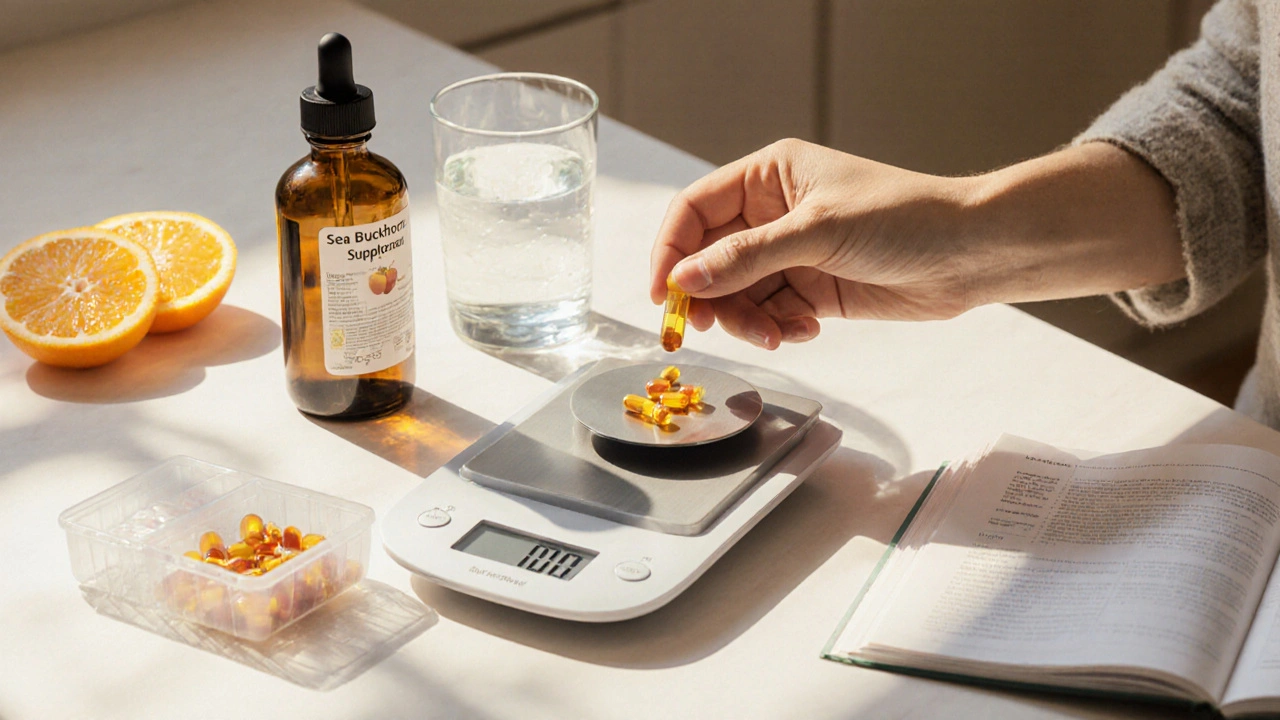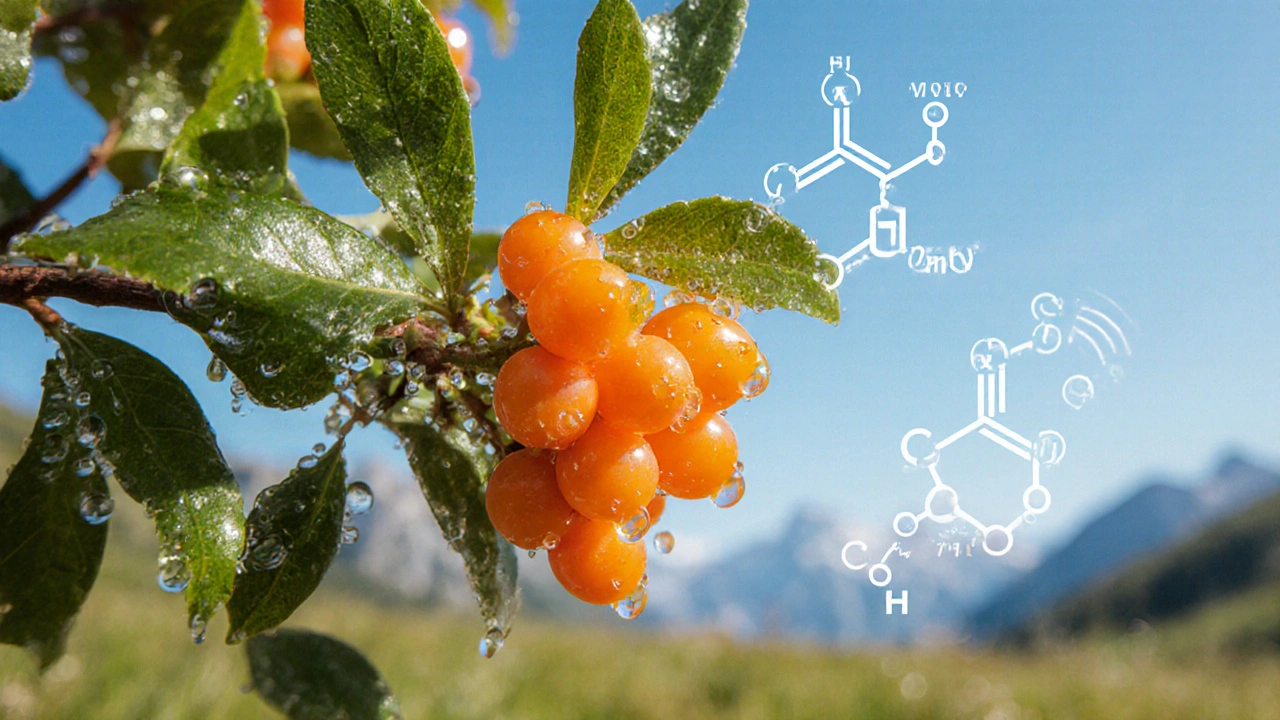Sea Buckthorn Supplement: The Science That Makes It So Effective
 Sep, 29 2025
Sep, 29 2025
When you hear the buzz around a new superfruit, you might wonder what really sets it apart. Sea Buckthorn is a hardy shrub native to the Himalayan foothills and coastal cliffs, and its bright orange berries have earned a reputation as a potent dietary supplement. Sea Buckthorn (Hippophae rhamnoides) delivers a unique blend of nutrients that support skin, heart and immune health. Below is a quick snapshot of why it’s gaining so much attention.
- Rich source of rare omega‑7 fatty acids
- Loads of vitamin C and beta‑carotene for antioxidant protection
- Contains phytosterols and flavonoids that help lower inflammation
- Clinical studies link the berry to improved skin hydration and cholesterol balance
- Generally safe for most adults when taken at recommended doses
What’s Inside the Berry? A Nutrient Deep‑Dive
Understanding the science starts with the nutrient profile. The berry packs a punch of micronutrients that work together synergistically.
Omega‑7 fatty acids are a rare family of monounsaturated fats found in high concentrations in sea buckthorn oil. Palmitoleic acid, the primary omega‑7, supports cell membrane flexibility and helps regulate lipid metabolism.
Vitamin C is present at levels up to 10 times those of oranges. This water‑soluble vitamin boosts collagen synthesis and protects against oxidative stress.
Beta‑carotene gives the berry its vivid orange hue. Converted by the body into vitamin A, beta‑carotene supports vision, immune function and skin health.
Antioxidants in sea buckthorn include vitamin E, flavonoids and polyphenols. These compounds neutralize free radicals, reducing cellular damage and inflammation.
Phytosterols such as beta‑sitosterol help modulate cholesterol absorption. Regular intake can contribute to healthier blood lipid profiles.
Flavonoids like quercetin and rutin add an extra layer of anti‑inflammatory power. Flavonoids also support vascular health by improving endothelial function.
Vitamin E works hand‑in‑hand with vitamin C to protect cell membranes from oxidative damage. Its tocopherol content is especially beneficial for skin barrier integrity.
How Each Nutrient Translates to Real‑World Benefits
Let’s break down the science behind the headlines.
- Skin Health: Omega‑7 fuels the production of ceramides - lipids that lock moisture into the epidermis. Paired with vitamin C‑driven collagen, users often notice smoother, more hydrated skin within weeks.
- Heart Support: Palmitoleic acid helps lower LDL cholesterol while raising HDL. Phytosterols block cholesterol absorption in the gut, creating a double‑whammy for cardiovascular health.
- Immune Boost: Vitamin C is a classic immunity champion. In sea buckthorn, its high concentration works alongside flavonoids that modulate immune cell activity.
- Eye & Vision: Beta‑carotene’s conversion to vitamin A is essential for retinal function, reducing the risk of night‑vision problems.
- Anti‑Inflammatory Action: Flavonoids and antioxidants inhibit NF‑κB pathways, the molecular culprits behind chronic inflammation.
What the Research Says
Scientists have been studying sea buckthorn for over three decades. A 2022 randomized trial with 120 adults showed that a daily 600mg sea buckthorn oil supplement lowered triglycerides by 12% and improved skin hydration scores by 23% compared to placebo. Another double‑blind study in 2021 linked 8‑week supplementation to a 15% rise in plasma vitamin C levels and a corresponding drop in oxidative biomarkers.
While not every study is large‑scale, the consistent trend is clear: the berry’s diverse nutrient mix produces measurable physiological changes.
Choosing a Quality Sea Buckthorn Supplement
Not all products are created equal. Here’s a quick checklist to help you avoid fluff and get the real deal:
- Source Transparency: Look for labels that disclose whether the berries are wild‑harvested or cultivated, and which country they come from. Wild‑grown plants often have higher phytochemical levels.
- Extraction Method: Cold‑press extraction preserves heat‑sensitive nutrients like vitamin C and omega‑7. Avoid products that rely on harsh solvents.
- Standardized Potency: Reputable brands list the exact amount of palmitoleic acid or vitamin C per serving. Aim for at least 300mg of omega‑7 per dose.
- Third‑Party Testing: Independent lab results confirm the absence of heavy metals, pesticides, and confirm nutrient claims.
- Form Factor: Oil, softgel, powder, or whole‑fruit capsules each have pros and cons. Oil offers the highest bioavailability for fatty acids, while powders are convenient for smoothies.

Safety, Dosage, and Potential Interactions
For most healthy adults, 500‑1000mg of sea buckthorn oil per day is well‑tolerated. Start with the lower end if you’re new to supplements and monitor how you feel.
Because the berry can affect blood clotting, people on anticoagulant medication (e.g., warfarin) should consult a healthcare professional before adding a high‑dose supplement. Pregnant or breastfeeding women should also seek medical advice, as research in these groups is limited.
Sea Buckthorn vs. Other “Superfruits” - A Quick Comparison
| Component | Sea Buckthorn | Acai | Moringa |
|---|---|---|---|
| Omega‑7 (Palmitoleic) | ≈ 10g/100g (high) | Negligible | Negligible |
| Vitamin C | ≈ 600mg/100g | ≈ 70mg/100g | ≈ 200mg/100g |
| Beta‑carotene | ≈ 30mg/100g | ≈ 4mg/100g | ≈ 5mg/100g |
| Antioxidant ORAC* | ≈ 7,000 µmol TE | ≈ 15,000 µmol TE | ≈ 2,500 µmol TE |
| Phytosterols | ≈ 400mg/100g | ≈ 150mg/100g | ≈ 250mg/100g |
*ORAC = Oxygen Radical Absorbance Capacity, a lab measure of antioxidant power.
While acai shines in overall antioxidant capacity, sea buckthorn outranks it in omega‑7 content and vitamin C levels, making it the go‑to choice for skin and heart support.
Putting It All Together: How to Incorporate Sea Buckthorn Into Your Routine
Here’s a practical 7‑day starter plan that lets you feel the benefits without overwhelming your system.
- Day 1‑2: Take one 500mg softgel with breakfast.
- Day 3‑4: Add a second softgel if you feel comfortable; monitor any digestive changes.
- Day 5‑7: Blend 1tsp of cold‑pressed sea buckthorn oil into a smoothie (banana + almond milk) for a tasty omega‑7 boost.
Track skin moisture, energy levels, and any changes in cholesterol numbers (if you have recent labs). Adjust dosage based on how you feel and the product’s potency.

Frequently Asked Questions
Frequently Asked Questions
What is the best form of sea buckthorn to take?
Cold‑pressed oil or softgels are most bioavailable for omega‑7. Powders work well in smoothies but may have lower fat‑soluble vitamin content.
Can I take sea buckthorn with other supplements?
Yes, it mixes nicely with vitamin D, omega‑3 fish oil, and collagen peptides. Just avoid high doses of other vitaminC sources to prevent stomach upset.
How long does it take to see skin benefits?
Most users report noticeable hydration improvements after 2‑3 weeks of consistent daily use.
Is sea buckthorn safe for children?
A pediatric dose of 250mg per day is generally considered safe, but always check with a pediatrician first.
Does cooking destroy the nutrients?
Heat can degrade vitamin C and some antioxidants, so raw juice or cold‑pressed oil retains the most benefit.
Ready to give sea buckthorn a try? Look for a product that ticks the quality boxes above, start with a modest dose, and listen to your body. The science is clear: a well‑sourced, properly processed supplement can deliver skin glow, heart health, and a stronger immune system-all wrapped up in a bright orange berry.

NANDKUMAR Kamble
September 29, 2025 AT 02:34Ever wonder why the media suddenly pushes sea buckthorn like a miracle? Maybe they're hiding something, but I'm keeping a low profile on this one.
namrata srivastava
September 29, 2025 AT 16:27From a nutraceutical engineering perspective, the bioavailability matrix of palmitoleic acid in cold‑pressed sea‑buckthorn oil demonstrates a synergistic photonic interaction with epidermal lipid bilayers, thereby substantiating its efficacy in dermal homeostasis.
Priyanka arya
September 30, 2025 AT 06:21Yo, sea‑buckthorn is like nature's secret weapon 🌟-if only the big pharma didn't want us to know! The omega‑7 vibes are seriously lit, and I'm all about that glow up 🍊✨.
Loren Kleinman
September 30, 2025 AT 20:14Sea buckthorn offers many nutrients that can help the body in different ways.
The omega‑7 fatty acids support cell membranes and help keep them flexible.
Vitamin C in the berries is much higher than in most fruits, which aids collagen production.
Beta‑carotene converts to vitamin A, providing benefits for vision and skin.
Antioxidants such as vitamin E work together with vitamin C to protect cells from damage.
Phytosterols may reduce the amount of cholesterol the gut absorbs.
Flavonoids like quercetin have anti‑inflammatory effects that can calm chronic inflammation.
Clinical studies have shown improvements in skin hydration after a few weeks of use.
Other research indicates a modest reduction in triglyceride levels with regular intake.
When choosing a supplement, look for cold‑pressed oil to keep the nutrients intact.
Third‑party testing is important to verify that the product is free from contaminants.
A typical dose of five hundred to one thousand milligrams per day is well tolerated by most adults.
People on blood thinners should talk to a doctor before adding a high dose.
Pregnant or nursing individuals should also seek professional advice.
Overall, sea buckthorn can be a useful addition to a balanced diet when used responsibly.
Amanda Joseph
October 1, 2025 AT 10:07Great, another superfruit happe-just what we needed 🙄.
Kevin Aniston
October 2, 2025 AT 08:21I totally agree with what you laid out, Loren. It's refreshing to see a balanced view that highlights both the potential benefits and the safety considerations. For anyone starting, I’d suggest tracking how their skin feels week by week, maybe using a simple moisture meter. Pairing the oil with a good night cream can amplify the ceramide effect you mentioned. If cholesterol is a concern, checking a baseline lipid panel before and after a month can give clear evidence of any change. And always remember to store the oil away from heat and light to preserve those delicate omega‑7s. Keep sharing the science, it helps the community stay informed.
kiran kumar
October 3, 2025 AT 06:34Sure the jargon sounds impressive but the real world data is kinda meh i doubt those fancy terms change the fact that most folks wont notice any difference
Brian Johnson
October 4, 2025 AT 04:47You've got a point about the hype, but I’ve actually tried the oil in my morning smoothie and felt a subtle boost in energy after a couple of weeks.
Justin Elms
October 5, 2025 AT 03:01Awesome tips, Kevin! Keep it simple and stay consistent, and you’ll see those glow‑up results in no time.
Jesse Stubbs
October 6, 2025 AT 01:14Wow, another pep talk? Seriously, if the oil works, it works-no need for a motivational speech.